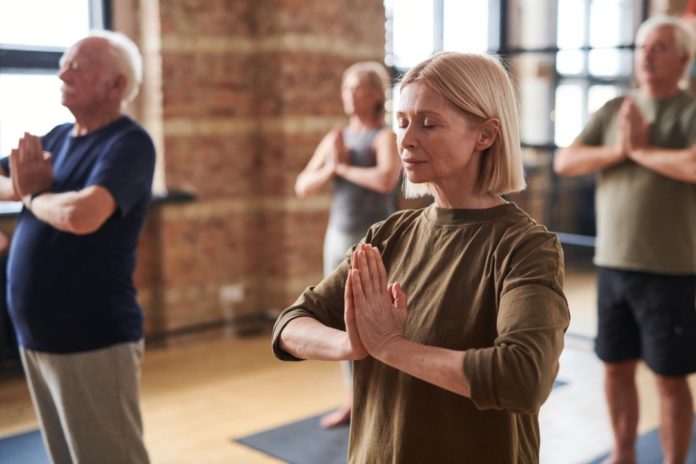Urinary incontinence is a common problem among older women. It occurs when the muscles around the urethra (the tube through which urine passes) weaken and lose tone. This causes leakage of urine during normal activity. The condition usually affects women after menopause. One study found that approximately 50 percent of women will at some point in their lives have issues with urinary incontinence. There are many treatments for urinary incontinence including lifestyle changes, medications, surgery, and physical therapy. Several studies have shown yoga to be an effective intervention for improving bladder control and treating this condition.
What is urinary incontinence?
It’s estimated that as many as 25 million Americans suffer from temporary or long-term urinary incontinence. This occurs when urine leaks out during physical activity or when pressure builds inside the bladder. It may happen suddenly or gradually. The most common cause of urinary incontinence is stress incontinence which happens during exercise, coughing, laughing or sneezing.
Causes of urinary incontinence
Older people are more susceptible because age weakens the pelvic floor muscles that help control the bladder. Unfortunately, age is not a dependable indicator of whether people can suffer from incontinence. Younger people can experience it because of disabilities or accidents weakening their bodies.
Pelvic floor dysfunction is one of the most common reasons for urinary incontinence in women. If muscles that support the pelvic organs become weakened and lose muscle tone, you may not be able to control your bladder fully. Tight pelvic muscles can mean that they are under constant strain. With more flexibility, you can better control them so that they can relax. Relaxed pelvic muscles can conserve their strength when you genuinely need them. These muscles are located between the bladder and vagina and play an important role in controlling urination. Pelvic organ prolapse also contributes to urinary incontinence. When these muscles fail to hold up the uterus, intestines, or rectum, they bulge into the vagina.
How yoga helps reduce incontinence symptoms
Balances your pelvic floor
Yoga can help you strengthen your pelvic floor muscles and relax your tight ones. Stretching exercises strengthen muscles that support the bladder and other pelvic organs. Breathing techniques improve blood flow throughout the body, which helps keep the pelvic area healthy.
The mula bandha (root lock) is one of the best pelvic floor muscle exercises in yoga. It strengthens the pelvic floor muscles which helps prevent urine leakage. Mula bandha is a contraction of the pelvic floor muscles. In addition, these pelvic floor muscle contractions improves blood flow to the pelvis and increases abdominal strength. This makes it easier to hold urine during times of stress. You can apply mula bandha to strengthen your pelvic muscles in almost all of the yoga poses.
The most important poses to focus on to improve your pelvic floor muscle function are:
Improves your posture
A surprisingly effective way yoga can help with urinary incontinence treatment is proper posture. One of the reasons for incontinence is stress applied to the bladder. It usually means something applies pressure to the bladder, pushing the liquid inside out. Strong muscles prevent the leak, but you can also avoid this by preventing the pressure from happening. Proper posture like standing straight or sitting properly ensures that there is no pressure at all on your bladder. Yoga poses are an excellent help because it improves balance and strengthens the core and back muscles to prevent slouching. It also helps with breathing, so your diaphragm doesn’t push down to your bladder. You will feel less pressure as you walk around with better posture.
Learning to be more aware
Yoga is also a meditative exercise. It ensures a better awareness of your physical condition and limits. With urinary incontinence, you need to know what is happening with your body. Most of the time, your body will warn you about your incontinence. It should allow you to be on your way to the bathroom before anything happens.
Improves mental health
Meditation, mindful breathing and yoga exercises can all help reduce stress, worry and tension. You learn how to cope with stressful events and find peace within yourself. Learning to relax will help ease some of the tension in your body. Relaxed muscles are able to conserve their strength for when they are necessary, which is good for incontinence.
Improved physical condition
While the pelvic floor is the focus of most urinary incontinence prevention efforts, a healthier body will help make things easier for those who suffer from incontinence. The core muscles in your abdominal area also help keep your pelvic floor strong, and yoga can strengthen them. Yoga can also get you on the path to losing weight. Excess weight around your midsection can put more pressure on your bladder, especially when sitting down. Losing weight can allow you to control your incontinence better. It also ensures you are healthy for a longer time. For those who are not elderly, practising yoga can be a path to recovery and preventing incontinence.
Yoga’s benefits can go beyond helping with urinary incontinence. It also gives people more robust and flexible bodies, improving general health and boosts overall quality of life. Even if their incontinence does not go away, they will feel better. You may wish to consult with an experienced yoga therapist to see if it could help with your situation.
Conclusion
Yoga is not a cure all, but it has been proven to improve the lives of many people. When used correctly, it may provide relief and even prevent urinary incontinence problems. You may need to consider other treatments for incontinence and lifestyle interventions to successfully manage pelvic floor disorders and urinary incontinence. You can find tips more healthy practices to treat incontinence and urinary leakage in this article from Molicare.


























